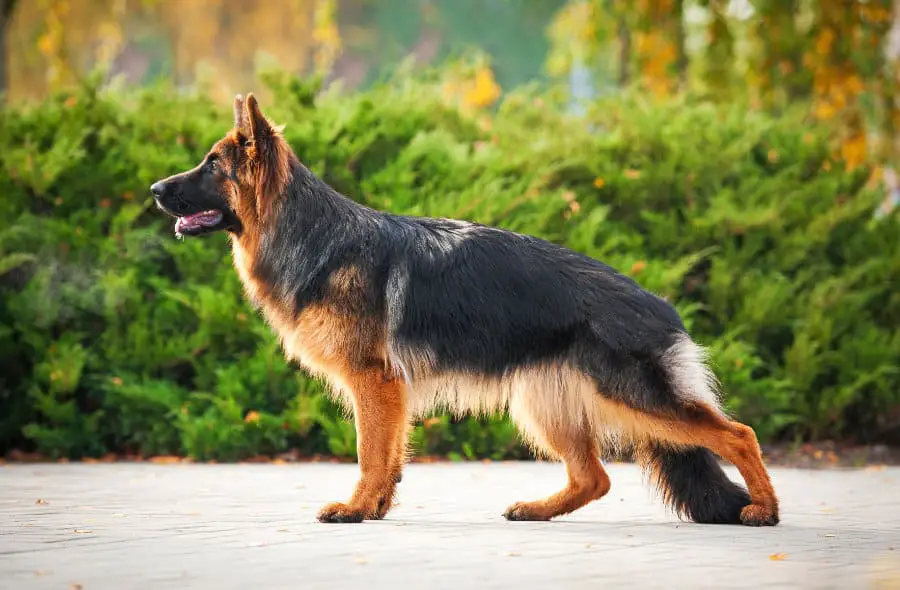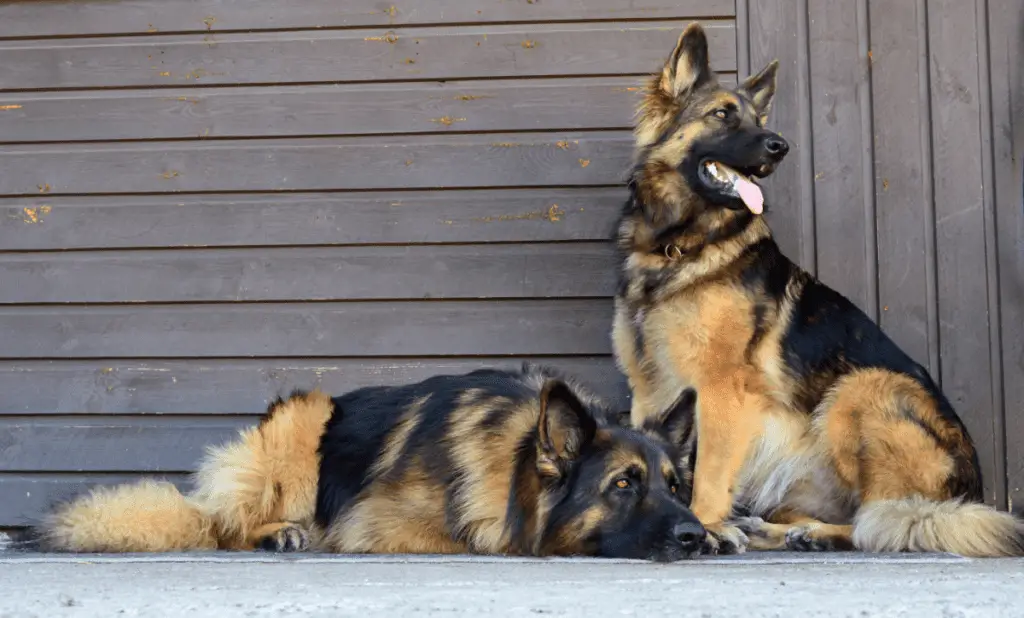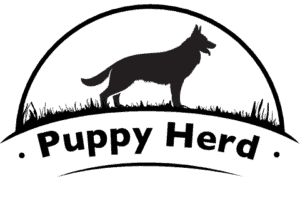German Shepherds are popular dogs. They have also been known as Alsatians or Alsatian Wolf Dogs. People don’t always think about what the original purpose was for breeding that specific dog. A dog’s function determines temperament and behavior. It is crucial as it influences the way the dog interacts with people and other animals.
German Shepherd Dogs were initially bred as shepherds to protect and herd sheep in the German countryside. They were intensely loyal, intelligent dogs that loved to work. German Shepherd Dogs fulfill functions such as police, military, security, service dogs, and of course some are kept as wonderful pets.
In this article, we will take a look at the history of German Shepherds. This will include their original function, how the breed has developed, and its current use.

Where Did German Shepherds Dogs Originate?
German Shepherd Dogs (GSDs), as their name suggests, came from farming communities in Germany. They were used there to herd sheep and sometimes cattle. The farmers tried to breed dogs that were fast, strong, intelligent, easy to train, and could be relied on to protect the livestock. During the early eighteen hundreds, these dogs had similar temperaments but looked very different from each other. They were referred to as German Shepherds (known as Deutsche Schaferhunde in German) due to their function and the country of origin rather than because they were similar dogs.
In 1891 a group called the Phylax Society was formed to try and establish standardization in the breed. Sadly as so often happens with committees, they could not agree on the sought-after physical characteristics, and eventually, the Society disbanded.
The Beginnings Of Modern German Shepherds Dogs
Max von Stephanitz was a member of the Phylax Society. He had attended the Berlin Veterinary College and had a passionate interest in dogs. Max ascribed to the belief that dogs must have a function and should be bred for working. He frequented dog shows, studying working dogs and their characteristics. In 1899 as was his habit, Max was attending a dog show. He came across a dog with the illustrious name of Hektor Linksrhein. Hektor came from another passionate but unknown breeder who had been breeding selectively to achieve a solid, strong working dog. Max was ecstatic and purchased Hektor immediately.
Max changed Hektor’s name to Horand von Grafath. Horand, was loyal, intelligent, strong, and quick to learn. Max decided to start the Society for the German Shepherd Dog. Horand was the first dog registered in this Society and became the breed standard. Horand was bred to many bitches, and the puppies that met the required criteria were registered with the Society. One of the main aims of the Society was to continue a line of dogs that were work-orientated. This aim complied with Max von Stephanitz’s belief that dogs need to fulfill a function and should have a job to do.

German Shepherds: The Perfect Police Dogs
Max von Stephanitz was so convinced of the superiority of the dogs he was breeding that he sent some out on loan to the German Police Force. This was the first time a canine unit was established in the German police. The dogs’ work ethic, ability to track, and trainability soon made them famous in the police department. In 1914 a trial was run where German Shepherds were introduced into the military. They excelled in all the jobs they were given and soon became an integral part of the German military.
Popularity In The United States And Europe
During the course of World War I, soldiers from the United States, Britain, and other parts of Europe came across German Shepherd Dogs. These dogs were being used by the Germans in the war. The dogs were used as guards to find wounded soldiers, carry ammunition or supplies, and scent dogs. They played a vital role in moving messages between different platoons of the German military. Soldiers from both sides were so impressed with the German Shepherd Dogs’ ability that they befriended and smuggled many of these dogs home with them. These friendships between the dogs and the soldiers helped to spread the German Shepherd breed all over the world. Wherever they went, they became intensely popular.

What’s In A Name – German Shepherd Or Alsatian?
The breed was originally called German Shepherd Dogs. After World War I and II, anything related to Germany was unpopular and unwanted. To overcome this prejudice, the name of the dogs was changed to Alsatians.
Alsace is a region in north-eastern France and borders Germany in the area where the first German Shepherds were bred. For many years the name Alsatian persisted amongst English speakers. In 1925, the American Kennel Club changed the name back to German Shepherd Dogs. The British Kennel Club only changed the name back to the original German Shepherd in 1977. Many persisted in calling the dogs Alsatians. Some people even believed that Alsatians and German Shepherds were similar but different dog breeds. They are, in fact, the same breed with a confusing history of names.
The Development Of German Shepherd Dogs
The fiercely protective nature and loyalty of German Shepherds were always emphasized in breeding programs. As the number of farmers decreased due to increased industrialization, so did the need for shepherding dogs. German Shepherds had become very popular through the motion picture and television series Rin Tin Tin and other Hollywood movies. They became popular as household pets but did not always fit in well due to their work drive.
Many German Shepherds were chosen and trained as military, police, rescue, therapy, or service dogs. Their intelligence and trainability made them very popular with dog enthusiasts who trained their dogs in obedience and other sports.
As it can be seen from this varied use of German Shepherds, there were soon different lines that were bred. Some genetic lines in German Shepherds were bred exclusively as working dogs. They excelled in the military, police, and other security services. These dogs had a high prey drive and a need to work. Other dogs were bred with less intense, gentler temperaments and could function as pets or service dogs, although they always did best when they had some job to perform.

Form Vs. Function: The Modern Day German Shepherd
In many show German Shepherds, the breeders forgot the original aim of having functional working dogs. They began to breed the dogs with sloped hocks or backs. In some dogs, this disorder is so extreme that these dogs struggle to move normally and are prone to degenerative spinal myelopathy. Elbow and hip dysplasia have become common in a large number of genetic lines.
In 2016, there was an enormous outcry over a German Shepherd dog competitor that won Best In Show. The dog appeared to be crippled by his extremely sloping hocks. This incident has raised awareness and controversy over whether German Shepherd Dog breeders should breed dogs with sloping back conformation.
Fortunately, not all lines of German Shepherds have these problems. Buying a healthy German Shepherd needs to be carefully researched. Responsible breeders test their dogs for genetically inherited conditions. They do not breed with dogs that do not have good hip and elbow scores. A dog with a high work ethic crippled by painful joint disorders makes for an extremely frustrated, unhappy canine. It can cost owners financially and emotionally to have to manage or surgically correct orthopedic issues.
Final Thoughts
German Shepherds Dogs originated as sheep herding dogs on German farms. They differed physically in many respects. They were selectively bred by Max von Stephanitz into a breed of dogs that had specific physical characteristics. Above all, though, Max emphasized the breeding of strong functional working dogs. He was highly successful, and the German Shepherd Dogs were soon accepted in the German military and police.
They have fulfilled many functions over the years, from security dogs to search and rescue dogs and service dogs. They are dogs with a need to work and the intelligence to carry out the required jobs. Their intense loyalty endears them to their owners and handlers. It is common for military or police personnel to adopt retiring dogs that they have handled in their careers. There is such a strong bond between the handler and dog that they cannot face losing their partners and choose for the dog to become a pet in their homes.
